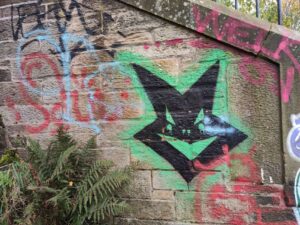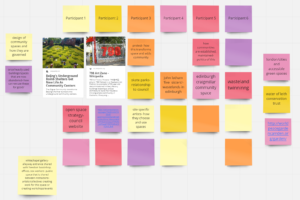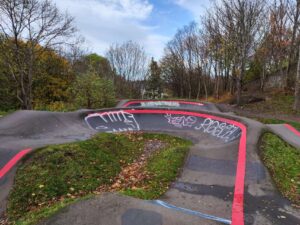Learning Sprint 4 | The Commons: Reflective Analysis
‘…consider how the arts and contemporary theory structure “the commons” anew: how the commons becomes both a goal and a trope in post-millennial art and cultural theory.’ (Amy J. Elias)
In this Sprint, I was introduced to a completely new concept – the commons. As I progressed in my studies, I realised that although the concept of the commons was new to me, it is actually everywhere in our lives. The commons is a cultural and natural resource that is accessible to all members of society. It can be a library or museum, a gallery, a piece of land, a river, or even air and sunlight. These shared resources can be privately owned or communally shared by the community, but they are all shared by the group. I note that the nature of the commons as a communal resource is similar to the Open Educational Resources (OER) mentioned in previous courses, in that they both serve the purpose of sharing and passing on resources. However, unlike OER, the commons relates to various aspects of our lives, whereas OER focuses mainly on the communication and sharing of learning resources.
Naturally, the commons is also closely related to the artistic sphere. In my view, the commons and art are mutually beneficial. The public space provides a place for artistic exchange, and the venues necessary for the practice of artistic exchange, such as museums and galleries, are all part of the public space, and they are central to the development and exchange of art. Nowadays, with the development of science and technology, art is not confined to traditional forms of offline communication; the internet also provides a public space for art communication. In turn, art contributes to the development of the commons; art galleries need the support of artworks to form and develop, and art communities need the support of artists. Even public spaces that are not associated with the arts can incorporate artistic elements if people so wish, such as the graffiti that can be found on the streets of Edinburgh, which is part of street art.

Early in the group discussion, our Basho member began by giving us an example of a project her previous course tutor had done – a project to renovate underground bomb shelters in Beijing. This project aimed to rebuild the underground bomb shelters in Beijing to create a community among the residents and give them more space to live and move around. The project is similar to transforming abandoned plots of land and creating new public spaces for people to engage in new social activities. It reminds me of the 798 Art District in Beijing, an art community that was formerly a complex of military factory houses, which was transformed into studios and galleries by artists and the Central Academy of Fine Arts after its productive function was abandoned. With several exhibitions running smoothly, the government took over the supervision and maintenance, and it has now developed into the largest art exchange community in Beijing.

These examples led us to focus our discussion on once heavily used buildings/spaces that are now abandoned, and although there are examples of the redesign and use of abandoned places around the world, for the purposes of our field research we focused on the Edinburgh neighbourhood. We finally found and researched SKELF Bike Park in Edinburgh. This is a park for cyclists, built near a mountain, with a curved track and no admission fee.

The park is well designed and the track is challenging and fun, allowing cyclists to challenge their skills and have fun in the sport. The footprint of the track is well designed and makes good use of the park’s space resources. However, on our initial arrival, we found the park to be in such a derelict state that we wondered if it was even being used today. During our research time, we did not meet the actual users of the park, only the winding track and the passers-by. It had rained just a few days before, leaving the track waterlogged and mossy, and the lack of street lighting meant that it could not be used at night. This led us to question the safety of the park and to discuss the park’s management, which on the day of the research was shown in a state that led us to believe that the park was not managed, but was a self-organised site for cyclists, and therefore lacked the relevant safety and hygiene management.
But as we investigated more deeply, we found that it was only because November is the off-season for this park, and the park has a management team in place for this. We found the park’s official Facebook page and discovered that the park’s activities are mainly focused on the months of May to September, when the weather is suitable for cycling and therefore the managers hold events to encourage people to participate. But apart from these months, the park presents itself as abandoned for most of the year. This means that, except for a few months during the high season, the SEKLF Bike Park remains unused as a commons resource for the rest of the year.

We have therefore focused on the ‘off-season’, proposing activities for the park that can be done even in unsporting temperatures, with the aim of making the most of the park’s resources and adding to the richness of the activities on the common. We started by focusing on the large areas of graffiti in the park. The graffiti appears on the track and on the nearby walls and blends in well with the surroundings, so we thought we could invite some artists to interact with the park to create graffiti or sports equipment with graffiti elements. Secondly, we noticed that there are many dog walkers in the park, so we also envisaged dog-owner interaction competitions, such as obstacle courses. The surrounding mountainous environment could also be used to design nature observation activities to guide people to observe and protect the existing natural resources. Finally, we think we can also make use of the internet to develop some online and offline activities and design the park as a virtual booth for artists who want to showcase their work.

Reference:
‘Commons’ from Wikipedia: Commons – Wikipedia




Recent comments